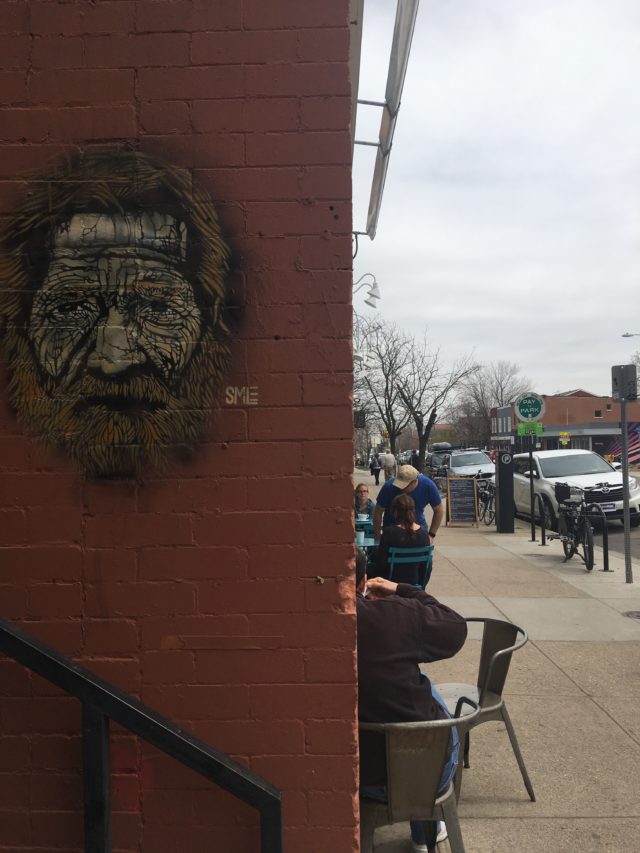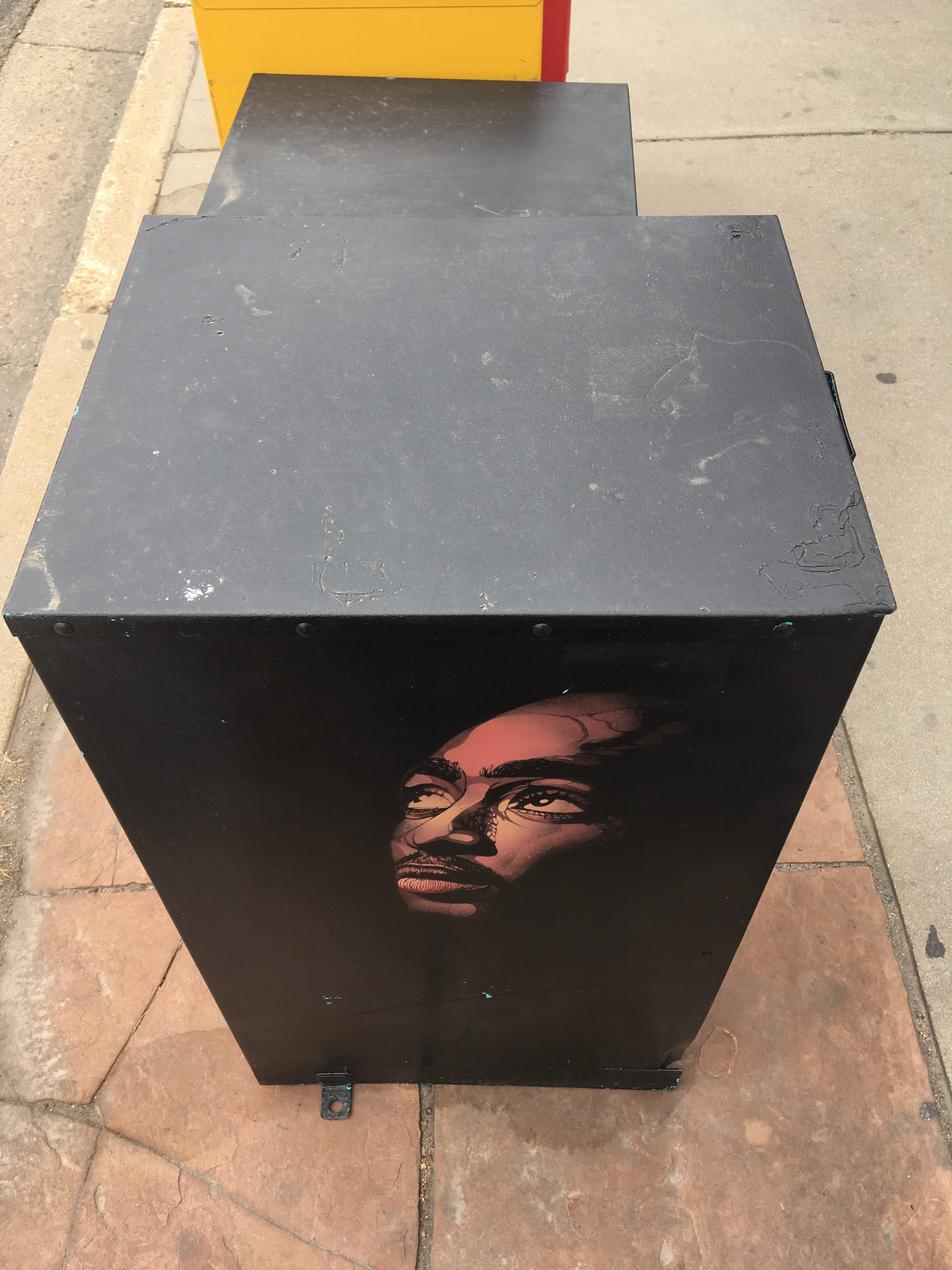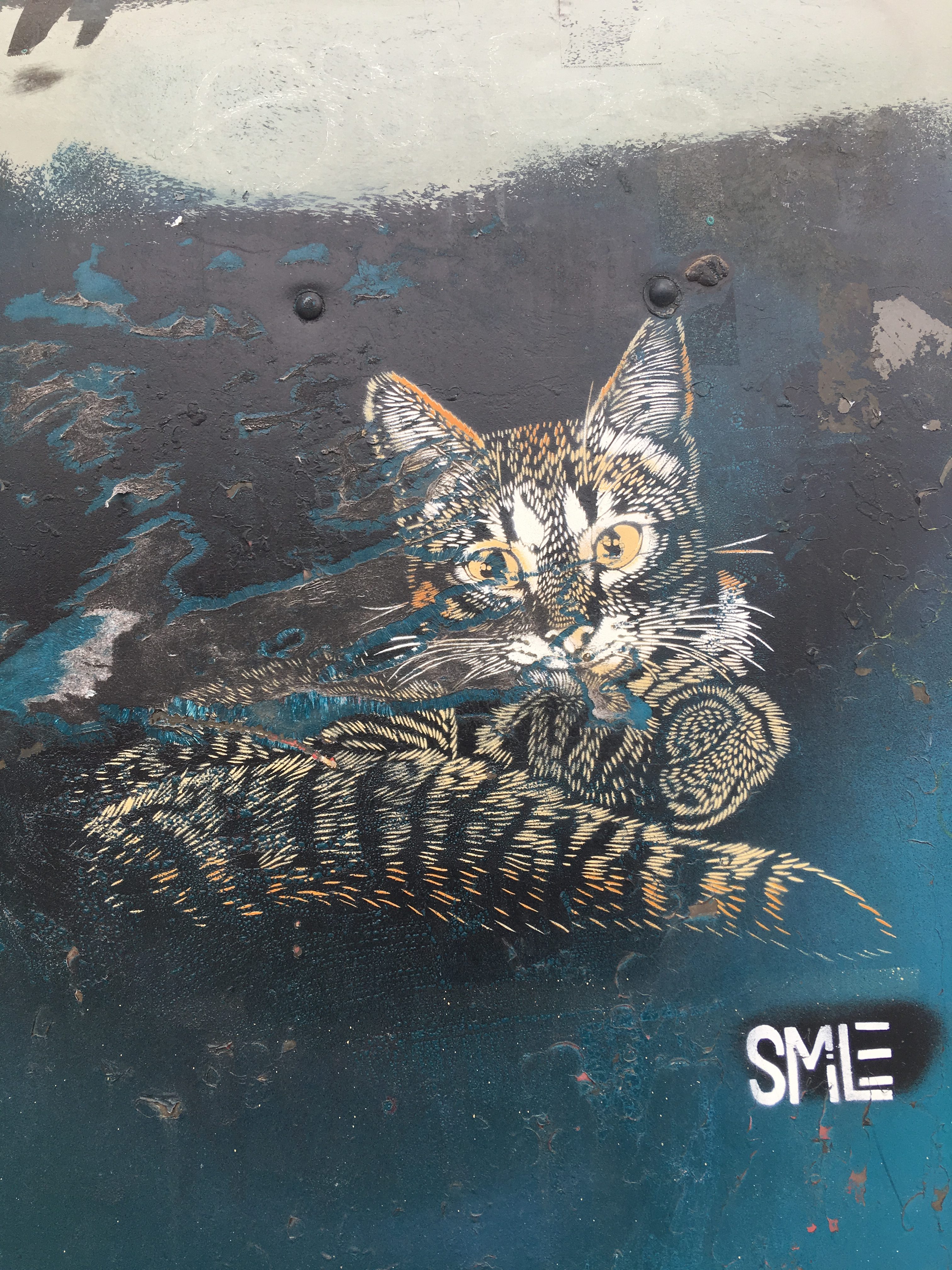
Ten minutes before I turn onto Pearl Street, my phone vibrates. A message: “I forgot to ask… Will you keep my identity a secret?”
I’m en route to a cafe, meeting the person responsible for the impressionist cats, portraits and landscapes sprinkled around Boulder’s downtown electrical boxes, alleyways and forgotten doors — like the tri-color tabby’s face that stares at me from a brick wall on 17th Street.
“Of course,” I reply. Inside, I order a coffee and scan the crowd. What does an incognito graffiti artist look like? Painted or dirty nails? Long hair, makeup? Grunge or hipster? Another vibration. “Look for a pair of sunglasses resting on the table,” he (which he may or may not be) tells me.
I walk toward the back of the room and spot them: The glossy lenses staring up from a two-top, flanked by an elbow on each side. One hand loosely cups a mug, the other rests flat on the table. The person is leaning forward, shoulders slightly rounded, gazing down as though examining the creamy chai’s layered design.
As I approach, he looks up. “You must be Emma,” he says.
So this is what a graffiti artist looks like. Not what I expected. More babysitter, less hoodlum. “You must be SMiLE,” I whisper as I sit down.
He glances around the room with fugitive eyes, nods, and we begin.
I ask him about his artwork — the intricate, layered paintings that decorate downtown, some legal, some illegal, all clearly influenced by the likes of Matisse and Van Gough and Bansky — and how he got started in the graffiti business.
“Well, I’ve been in art my whole life,” he says, rotating the mug around in his hand. After graduating high school in Boulder, “I was actually doing gallery shows, trying to get into the art world.” But something didn’t quite click for him — it required conformity.
“It didn’t happen; it wouldn’t work for me in there. I’ve always been this very wild, rebellious person,” he says. “And you know… you have to harness your strengths in life.”
He won’t tell me the kind of art he practiced in the gallery setting. “I won’t get into that,” he says, eyeing me as though I might use the info to trace his identity.
 He didn’t always go by SMiLE, his current pseudonym. The name came to be late in 2015, and though it was something of a spontaneous decision, he liked how it encompassed his art’s primary mission: to zap people on the street into the present moment, to deliver a quick spritz of happiness.
He didn’t always go by SMiLE, his current pseudonym. The name came to be late in 2015, and though it was something of a spontaneous decision, he liked how it encompassed his art’s primary mission: to zap people on the street into the present moment, to deliver a quick spritz of happiness.
SMiLE’s first painting was a cat, a simple one, which eventually evolved into a trademark of sorts. He estimates about two dozen of them now look over the streets of Boulder.
“To be honest, I’m kind of a cat fanatic,” he tells me with an honest-person’s shrug. “I love cats, I grew up with them, I was an only child. I had a lot of family and good friends, but they’re not there at 9:15 p.m. on a Tuesday night. So I’d hang out with him, well, a couple cats, but one in particular for a long time. I painted him around town.”
SMiLE leans in a little closer, “Every single time I’m out, a cat comes up like, ‘What are you doing hanging out on Pearl this late?’ They’re curious. I kind of feel they also have this sense of running wild, out there at night.”
Soon after nixing traditional art, SMiLE left Boulder. Weaving through the humid streets of the Middle East and tip-toeing around Europe’s cobblestones, he used public art as a way to navigate and understand foreign cultures. “The whole time I was traveling, what stood out to me, and still does, is graffiti, street art, everywhere I go.” It was like a shared language he could tap into and use to gather tales of history and culture and politics and social realities, he says.
“Paris is the heart of it all,” he says, describing the place where the origin story of street stencil art began. His voice grows incrementally louder as he retells lessons from French artistes de rue — about how during the 1968 French social revolution it was students that cultivated the power of stencil art. On street corners, they’d use little paintings to coordinate movements and rallies. And after the French riots simmered down, painted stencil images continued to pop up as a form of anti-establishment expression, fomenting a surge of European stencil art that swept through streets in the ’70s. Eventually the style migrated to the U.S., and by the ’80s, stencil art became a popular manifestation of cultural identity and counter-cultural statements.
After traveling, “I knew my strength in art, and realized street art is a way to have social impact,” SMiLE says. “Sure, I could’ve gotten into murals, but it’s corporate, it’s predictable. This incognito stuff, I felt like this is a strength.”
Back in Boulder, SMiLE began populating the city with his art — a way to infuse Boulderites with a healthy dose of make-you-reconsider-the-status-quo reminders. In a world that’s always rushing, he wants people to slow down; when society demands we fret about the future, he wants to reel you back to the present. “To me that’s powerful, having a modern rebellion.”

 It’s dark and 21 degrees in Boulder, and SMiLE is huddled over his garage table. A light illuminates a sheet of glossy, flexible-but-durable paper in front of him. Using an exacto knife, SMiLE slices one of a thousand little slits in the sheet with surgical precision. In an hour or so, once the streets calm down a bit more, he’ll take this sheet and three others (also dotted with cuts and slices) downtown.
It’s dark and 21 degrees in Boulder, and SMiLE is huddled over his garage table. A light illuminates a sheet of glossy, flexible-but-durable paper in front of him. Using an exacto knife, SMiLE slices one of a thousand little slits in the sheet with surgical precision. In an hour or so, once the streets calm down a bit more, he’ll take this sheet and three others (also dotted with cuts and slices) downtown.
As he exhales, a cloud of fog dissipates. One more carve and slice, and it’s done. Each sheet is cut and treated as one layer or one color, of the finished painting. It used to be some paintings would require up to eight layers, but now SMiLE can do the same in four. He gathers his things — a few cans of spray paint, the four completed stencils — and gets dressed — a button-up shirt, slacks. Dressing like a typical party-goer on Pearl Street has helped him evade the curiosity of police late at night. Spray paint cans work well as a faux cell phone in the cover of darkness, he’s learned.
When he started painting the streets, choosing a place to arrange his art wasn’t as obvious a decision as it is for him now. In hindsight, he says it’s no surprise the Bob Marley portrait on the old folks’ home was covered up in less than three days. A music shop would’ve been a much better canvas.
Overall, SMiLE says he tries to paint “in spots I feel are respectable — not really on a business or where it’s new and shiny. I try to put them in places that look defunct and derelict.
“This is like my home,” he adds, gesturing down Pearl Street. “That’s a lot of it, adding something to our community that’s surprising people. People see it and wonder, ‘How did he do that? Whoa, did they come out in the middle of the night? Is it against the law? Did they get permission?’ And I like that sense of liminality, unknown.
“But typically, one person’s complaint is all it takes,” he says, “and they’ll cover it up.” SMiLE estimates about a third of his paintings are eventually removed. “It’s part of the game, I guess. I don’t like it to happen, but it’d part of the risk you take.”
You have to be strong and power through it, he admits, but he doesn’t deny it adds to the allure. “About a hundred feet that way, that portrait in the little alley, it’s been there for six months. Just now I walked by and it’s covered over. It’s OK, I don’t even mind. I kind of smile, like hey, it was there for that long. I know a lot of people liked it because they’d share it online. That’s just kind of part of the organic process. Some make it four days, some make it two years.
“One of the first ones I ever put up, on the side of Boxcar cafe, is still there. If I would’ve known it was going to make it that long, I would’ve planned it out, some big, giant cat or something. But you never know,” he says with a shrug. “It’s a thrilling, addicting type of thing.”
(I later asked a Boxcar Coffee Roasters barista about having a graffitied piece of art on the building’s exterior, and he told me, “I think it’s cool. I like it.”)
Once midnight passes, SMiLE approaches his brick canvas. He has a window between 12-2 a.m. After that, the bars close and hanging outside becomes too suspicious.
He places one stencil up on the wall and sprays smooth across the sheet. The glossy white hue settles on the exposed brick. He removes the stencil and steps back, waiting for it to dry. It can take between one and four minutes, depending on the color, before he can start the next layer. Because it’s white, SMiLE waits three minutes, then places the next stencil on top and sprays again. Within 15 minutes everything is done. He packs up, returns home, and wakes up with just enough time to get to the office by 8 a.m.

 SMiLE imagines people walking down the street and seeing the Starry Night Flatirons painted on the Fox Theatre’s door, or Chief Niwot’s portrait on an electrical box in Settler’s Park, or bell hook’s face on the side of Falafel King’s white brick wall. “The world is pretty locked-down,” he says. “We don’t ever feel our eruptions; at least it’s rare in our culture nowadays. … They see something that is illegal and they like it; they get excited and that kind of helps turn them. They’re like, ‘Huh, maybe all law-breaking isn’t bad.’ So, I think it gives them the impression like: ‘Hey, there’s someone with their hand up, too.’ Loosen up. The system is getting too tight.”
SMiLE imagines people walking down the street and seeing the Starry Night Flatirons painted on the Fox Theatre’s door, or Chief Niwot’s portrait on an electrical box in Settler’s Park, or bell hook’s face on the side of Falafel King’s white brick wall. “The world is pretty locked-down,” he says. “We don’t ever feel our eruptions; at least it’s rare in our culture nowadays. … They see something that is illegal and they like it; they get excited and that kind of helps turn them. They’re like, ‘Huh, maybe all law-breaking isn’t bad.’ So, I think it gives them the impression like: ‘Hey, there’s someone with their hand up, too.’ Loosen up. The system is getting too tight.”
He takes a deep breath. “Look. I don’t have a very good car. I live in a dump. I work a poor-man job and it sort of evolved into what I’m doing. You make a commitment to do certain things, and unless you’re wealthy you’re gonna have to short yourself elsewhere.” He looks down at his now-empty chai mug. “Where I’m at now, it’s worth all I’ve got.”
We leave the cafe and SMiLE walks me down the block to the Pharmaca building. A black-and-white cat with yellow eyes is painted on the lower southeast corner of the exterior. Someone else has added a soft red mark between its ears.
I’d been in Pharmaca before, to ask the two women behind the counter what they thought about having the cat painted on their building. “I love it,” one said before I even finished my question. “It adds culture, you know?”
When I stopped a pedestrian passing Pharmaca to ask how they felt when they saw the cat, they told me, “It’s quaint.” Then they took a closer look and said, “I guess I didn’t really notice it before.”
Another storefront manager, one who has a pizza-box-sized SMiLE portrait on the stairway that leads to his office door, told me, “In my personal belief, do I enjoy seeing artwork walking down the street? Absolutely.
“It creates vibrancy to any community when you see real artists placing art on any medium they choose. I don’t prefer going to an art gallery; I prefer the organic stage of what the art may be. That is a talented artist who did that. I have no issues with that, personally.” No one, as far has he knows, has complained about SMiLE’s art. “That’s the thing, would you prefer to see a plain brick wall?”
“When they see my art, I want them to be startled,” SMiLE explains, gesturing toward the Pharmaca cat. “They’re thinking about whatever the heck — their cat or their sick grandma or their grades or whatever — you know, something where they’re not present. I want them to see a painting and become present.”
When we leave Pharmaca, I ask SMiLE if he’s ever been caught. In Boulder, any graffiti or street art without permission is technically illegal. He tells me about a few close calls, but he’s never been caught. Ultimately, “They don’t care,” he says and we agree the police probably have bigger fish to fry.
SMiLE starts walking again. “I’m a pretty present person, for better and for worse. This is kind of like a way to help people join in,” he says in stride. “Like, come on into the moment. Hopefully, when people are present they’re happier. They’re gonna go back to thinking about their cat or grandma or whatever, but just for that moment to help them get present, I think that is the essence. That is what I get when I see street art, and that’s what I want to share.”
Before he says goodbye, SMiLE looks up at the sky. “I’d like to stay incognito forever. Eventually I’d like to live in Paris or Rome, part time. I know that sounds rich, but all I want to do is paint in the streets. Art inspires me.”














